Pacific Inter-Club Yachting Association
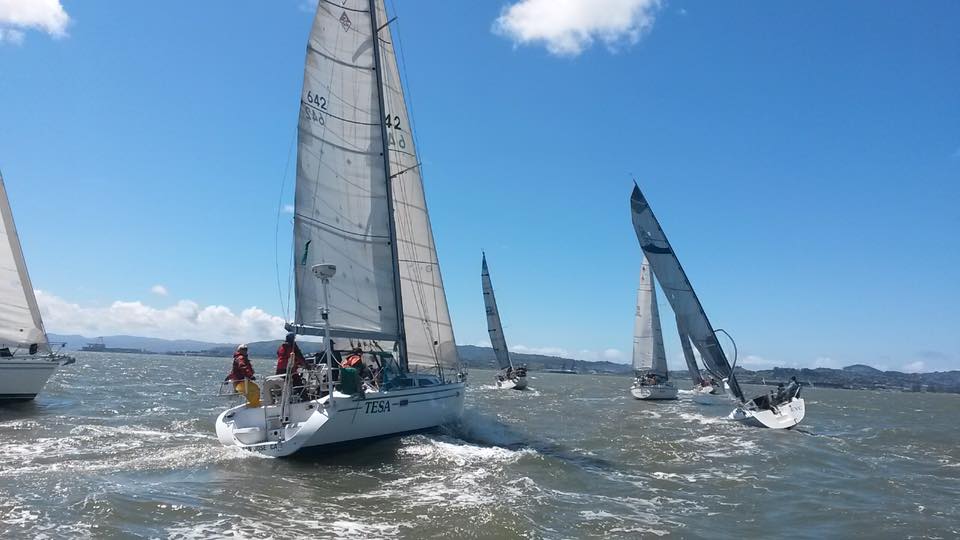
PICYA Commodore Patti Mangan received one of the first inkings of the USPS Building Bridges Special Postal Cancellation on Feb 18, 2021 at the 2pm Ceremony. PICYA was integral to the Golden Gate International Exhibition in 1939-1940, with an exhibit and several regattas.
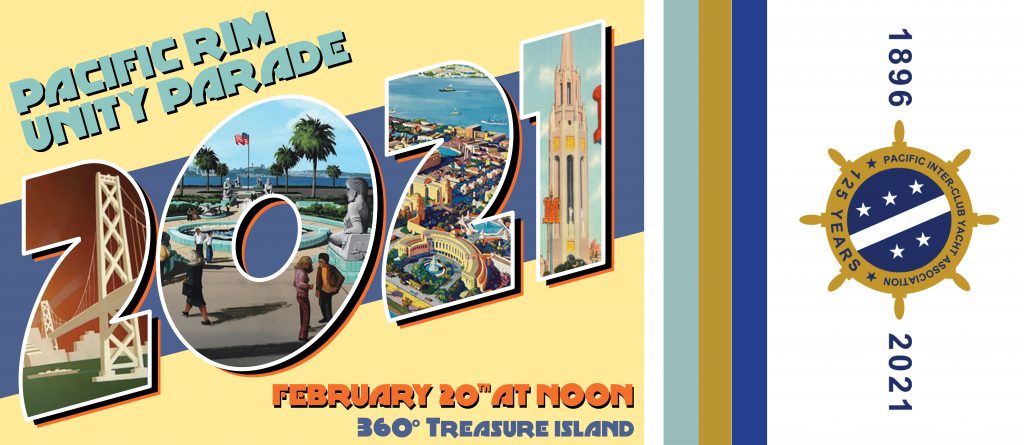
On Feb 20, 2021, PICYA organized a Pacific Rim Unity Parade, with sailboats and power vessels from its 107 yacht clubs circumnavigating Treasure Island from noon to 3pm. Live streams from cameras on the island, showed boats passing by since gathering on the island was not permitted during the pandemic.
The Pacific Inter-Club Yacht Association was formed in San Francisco, California May 12, 1896, with Charles G. Yale (San Francisco Yacht Club) as its first President. For some time prior to this, the major San Francisco Bay yacht clubs were considering an organization for inter-communication, uniform racing rules and to encourage yachting. The five charter clubs and the year they were founded were: California Y.C. (1893), Corinthian Y.C. (1886), Encinal Y.C. (1890), Pacific Y.C. (1873) and the San Francisco Y.C. (1869). None of the still existing charter clubs has maintained continuous membership in PICYA. South Bay Y.C. founded in 1888 joined PICYA in 1897
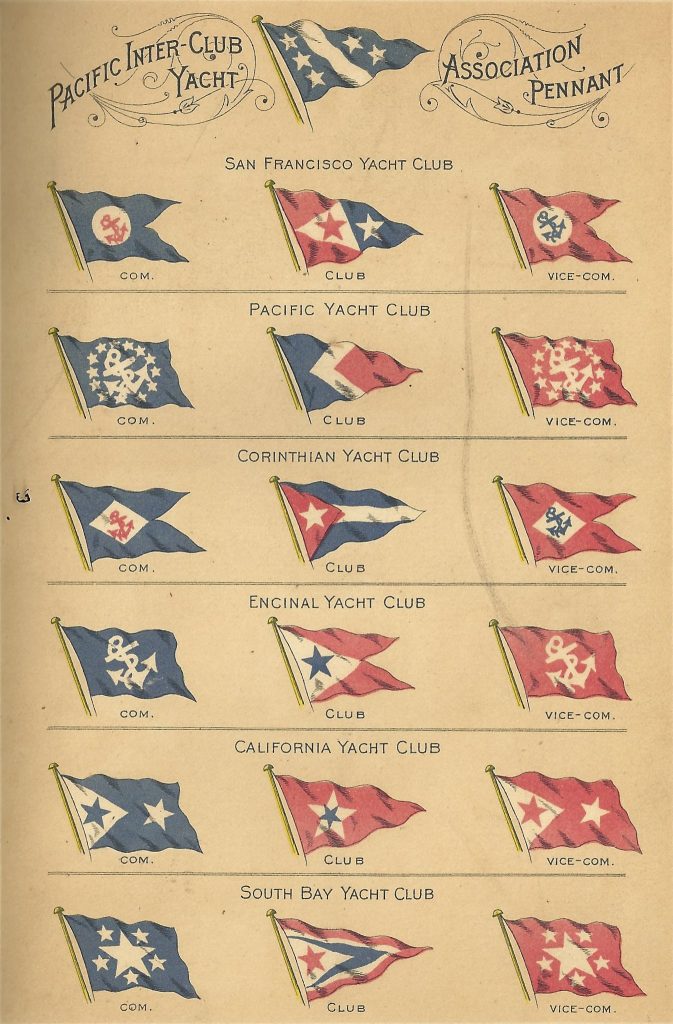
The Five Original Charter Clubs
The California Y.C. clubhouse was originally located on the west side of the Webster Street Bridge on the Oakland Estuary in Alameda. It was dubbed the “Oakland Navy” at the beginning and this “stuck.” Dissatisfied with the problems associated with the location, it tried to combine with Encinal Y.C. in 1901 without success.
The clubhouse was moved to Brooks Island in 1907. The logistics of transporting people and supplies proved to be too great and the clubhouse was moved to Key Route Basin in 1916-1919. Attempts to combine with Oakland Y.C. and Aeolian Y.C. at a Neptune Beach location did not work out. The clubhouse gradually deteriorated and their members gradually joined other clubs.
The club maintained a listing and various mailing addresses until 1933 in Lloyd’s Register of American Yachts. J. Porter Shaw was the last Commodore of record. Before 1919, the club had dropped out of PICYA and efforts to get it back into the fold proved fruitless. The second Richardson Bay Y.C. has adopted its burgee.
The Corinthian Y.C. has occupied its present site at Corinthian Island since 1886. The original clubhouse burned down. The present building has been improved over time and a harbor added. Its Centennial publication was 1986.
The Encinal Y.C. clubhouse was completed in 1891 at the south shore of Grand Avenue, Alameda. The property was sold in 1956 and the present clubhouse, on the Estuary in Alameda was built in 1960. The Centennial publication of Encinal Y.C. was published in 1994. The Pacific Y.C. clubhouse was in “old” Sausalito at “Hurricane Gulch.” It was disbanded in 1899. Benicia Y.C. adopted its burgee.
The first San Francisco Y.C. clubhouse was located on a long railroad wharf or “Long Wharf” at Mission Bay in San Francisco until 1877. After temporary locations, a clubhouse was located in “old” Sausalito about 1877. This burned down in 1897 and was rebuilt. Storm problems and oil pollution mainly caused the relocation to its present Belvedere site. The original small clubhouse has developed into the present one and the harbor was built. Its Centennial publication was issued in 1969 and a supplement was issued in 1994.
On June 24, 1903, South Bay Y.C. dedicated its present clubhouse. Although the building had been moved, spruced up with some additions and painted; it is still the original building with its first meeting taking place at the new location on April 11, 1985. A commemorative plaque was erected in February 1994.
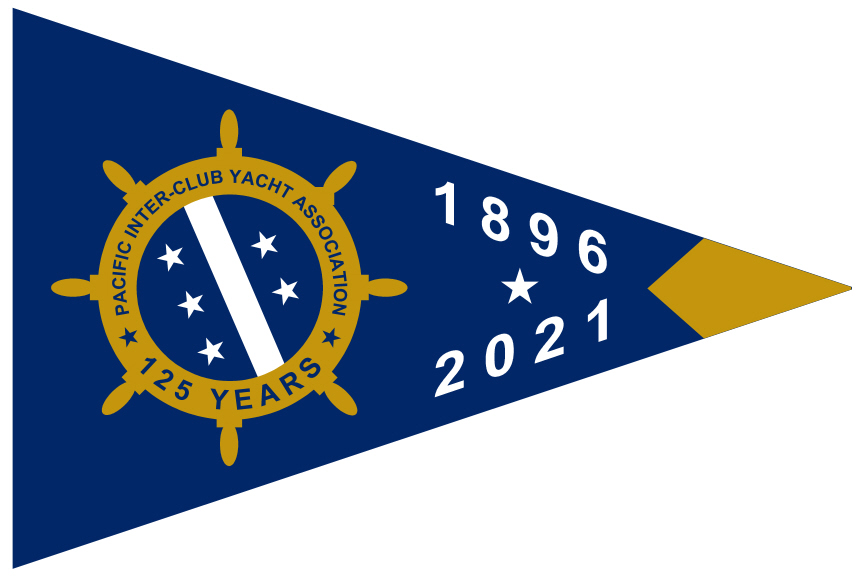
The PICYA Burgee
The original five star burgee of PICYA is still used today. There was a period when a new star was added when a new club joined. However, when eighteen stars were reached this became spatially impractical and the use of five stars was resumed. There is an indication that an adaptation with the two aft stars in the horizontal was used on a special burgee awarded to early placing racers.
PICYA Publications
The first major PICYA publication in 1898, after the original 1898 Bylaws were called “Yacht Signal Code for Use on San Francisco Bay and Adjacent Waters.” It was complied by George G. Edgar. It contained a code flag designation table with PICYA Member Clubs and Officer’s burgees in a color plate. Past PICYA Commodore Ward Cleaveland had the original and also had the flag plate enlarged.
An original copy of the 1898 PICYA Constitution and Bylaws had been located in 1990. This is still to be confirmed as of April 2013. A 1912 revised copy printed by Larry Knight was located and Larry then started the present Yachting Yearbook series with the eleven page “Official Program and Race Instructions for Season 1922.”
The 1923 issue, published simultaneously with the formation of a Pacific Coast Yacht Association sponsored regatta on San Francisco Bay was a masterpiece for its day. Larry Knight continued to publish the Yachting Yearbook until his death in 1966. It was taken over in succession by Hal Biggar (1967-1971), Ed Wilder (1972-1983), Burnett Tregoning (1984-1998), John Chalfant (1999 2006), Johnnie Owen (2007-2013) and Patti Mangan (2014-present).
The Yachting Yearbook has improved over the years in format, information and quality of print and color. As of 2024, it contains a listing of many types of PICYA trophies, awards, races, boating organizations, related articles by local writers and listing of over 107 member clubs with an index of all Members and all Boats contained within.
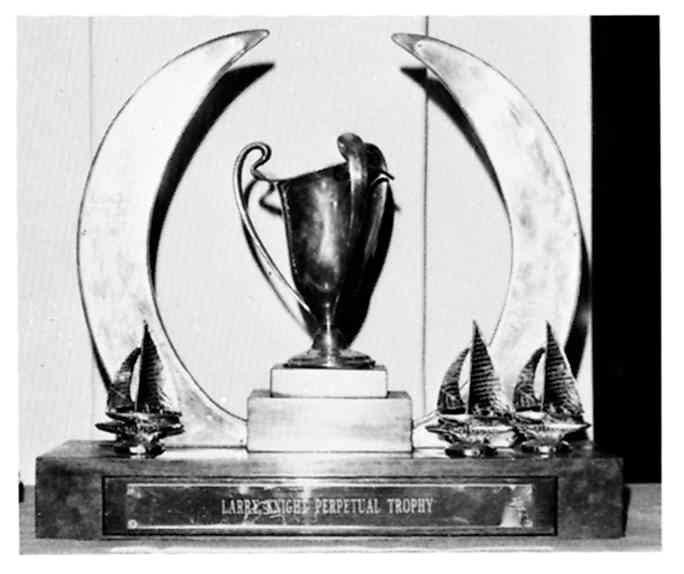

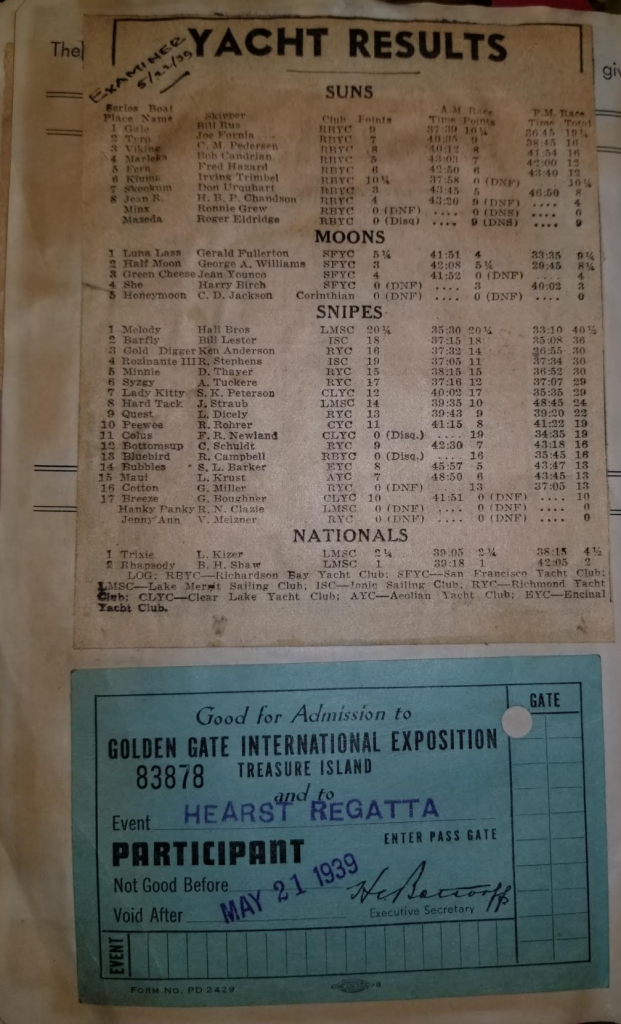
Early Regattas & Trophies
The first PICYA regatta was held on September 9, 1896, California Admission Day. Joseph M. MacDonough donated a sterling silver trophy in the name of his father Joseph MacDonough Senior, a prominent yachtsman active in PICYA and Commodore of Pacific Y.C. from 1881-1882. The first winner of the trophy was “Truant,” (CYC). MacDonough continued to donate cups until 1916 when PICYA began furnishing its own trophies. He also represented PICYA when the old North American Yacht Racing Union was formed, (now United States Sailing Association) to develop “universal” handicapping.
Another notable trophy is the 1913 Lipton Cup. Sir Thomas Lipton visited the Bay Area in 1912 and intended to field a 12-meter boat to compete with a San Francisco Bay boat during the Panama-Pacific International Exposition in 1915. However, the beginning of World War I made this impractical. The cup was raced in 1916, 1918, 1919 and 1920. The last three times won by John Hanify. He presented the cup to the Olympic Club for display but tragically, he lost his life in rough seas in 1922 and this ended interest in this class for racing along with the knowledge of where the Lipton Trophy was located.
It was ‘lost’ for roughly 40 years and ‘discovered’ in the display case of the Olympic club by Paul Marcucci of the San Francisco Y.C. It was returned to PICYA after negotiation and a new Deed of Gift was written with approval of the Lipton Estate effective September 1, 1960. The original Lipton Cup was melted in the St. Francis Y.C. fire of 1976. Irreplaceable, a modern sailboat replica was substituted.
In 1928, the Corinthian Y.C. and the St. Francis Y.C. took over most of the major sail races creating the Yacht Racing Association of San Francisco Bay. It was also partially sponsored by PICYA. “One Design” racing was started on the Bay as early as 1887 when the Mosquito fleet competed in races held by both the Pacific Y.C. and the Corinthian Y.C. Later PICYA fostered and encouraged building of the “Bird” (1992), “Star” (1923) and “PIC” (1936) class sloops.
As the reliability of the early gasoline engines improved, many powerboats races were held on the Bay, Carquinez Strait, the San Joaquin and the Sacramento Rivers as well as occasionally in the ocean. PICYA or individual clubs usually under American Power Boat Association rules sponsored these races.
Sail races were also sponsored by PICYA at the 1915 Panama-Pacific International and the 1939 Golden Gate International expositions. The Hearst Regatta was held on May 21st, 1939 – see results above. Such races were also held during the celebrations for the opening of the Golden Gate and Bay Bridges in 1935, 1936 and the Carquinez Bridge in 1927. Eventually the Northern California Power Cruiser Association emerged in in 1937 and the Predicted Log Racing Association oversaw powerboat racing in 1953.
Opening Day on the Bay
The largest single PICYA event is “Opening Day on the Bay.” This was a term used in the early 1890’s when it was associated with the first activities of individual yacht clubs celebrating the spring season.
It gradually became identified with the manual opening of the bridge at Corinthian Island, Marin County. This was an event viewed by yachtsmen and local residents as sailboats and “arks” passed through. These had been stored in Tiburon Lagoon to protect them from the ravages of winter.
Individual clubs held their own “Opening Day” celebrations either independently or jointly. The first PICYA sponsored coordinated event was held in 1917 at the suggestion of Gus Dorn (CYC). There is an annual “Theme” for decorated boats with many trophies awarded along with the “Benham” trophy, which is a competition for yacht club participation based on boats and distance traveled. Amended in 1968.
Legislative Boating Interests
One of PICYA’s greatest contributions to the betterment of boating has been its effort in the legislative field. 1965 marked the leap forward when the necessity for an organization to make legislators aware of boat owners’ needs and to guard against an increasing number of adverse bills being submitted in the legislature. This resulted in the nonprofit corporation, ‘Boat Owners Associated Together’ or B.O.A.T. formed by Past Presidents of PICYA as the first trustees.
The Southern California Yachting Association was contacted to bring their half of the state into the field. B.O.A.T. was then reorganized to emerge as a statewide organization in September of 1968 making it an effective state legislative watchdog. In 1983 the name was changed to ‘Recreational Boaters of California’ or R.B.O.C. Each year nine directors appointed by PICYA and nine directors appointed by SCYA join in Sacramento to visit with Senators and Assembly members from their areas. This has been a very effective method of communication. In 1970, its success was attributed largely to the capable work of Executive Director, Jerry Desmond and his staff and continues on to this day.
COTY
In 1993, Director George Neil of Richmond Y.C. developed the PICYA “Club of the Year” program to honor the clubs whose delegates were most effective in facilitating club participation in PICYA hosted events. Yacht and Boat clubs earned points in many categories including attendance at Delegates Meetings and participation in PICYA seminars and regattas. The member club with the most points at the end of each year is named PICYA “Club of the Year.” The first club to win this award was Bel Marin Keys Y.C.
Wheelchair Regatta
In 1997 Staff Commodore Margot Brown, (1995, first woman Commodore of PICYA) propose a Wheelchair Regatta. There were 8 boats and 68 veteran participants. Encinal Y.C. with its natural location and no public service event at that time was a good fit. There was a great deal of enthusiasm for the event at the time and it has increased in size and participation every year. It continues to be held at Encinal Y.C. on the last Saturday in September as PICYA’s charity event.
This “Brief History of PICYA” will be updated from time to time as more information becomes available. Most notably a separate chapter on the many trophies, regattas and awards that were added through the years. I would like to thank past Historical Chair Lloyd Ryland (1912 – 2006) for his diligent and meticulous work that has been a main source of information for this document and S/C Peter Nardini who worked on the Historical Committee at that time and who has been a consultant and member of the present committee.
